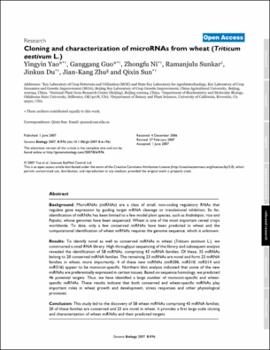| dc.contributor.author | Yao, Yingyin | |
| dc.contributor.author | Guo, Ganggang | |
| dc.contributor.author | Ni, Zhongfu | |
| dc.contributor.author | Sunkar, Ramanjulu | |
| dc.contributor.author | Du, Jinkun | |
| dc.contributor.author | Zhu, Jian-Kang | |
| dc.contributor.author | Sun, Qixin | |
| dc.date.accessioned | 2019-09-25T18:24:45Z | |
| dc.date.available | 2019-09-25T18:24:45Z | |
| dc.date.issued | 2007-06-01 | |
| dc.identifier | oksd_yao_cloningandchara_2007 | |
| dc.identifier.citation | Yao, Y., Guo, G., Ni, Z., Sunkar, R., Du, J., Zhu, J.-K., & Sun, Q. (2007). Cloning and characterization of microRNAs from wheat (Triticum aestivum L.). Genome Biology, 8(6), Article R96. https://doi.org/10.1186/gb-2007-8-6-r96 | |
| dc.identifier.uri | https://hdl.handle.net/11244/321446 | |
| dc.description.abstract | Background: MicroRNAs (miRNAs) are a class of small, non-coding regulatory RNAs that regulate gene expression by guiding target mRNA cleavage or translational inhibition. So far, identification of miRNAs has been limited to a few model plant species, such as Arabidopsis, rice and Populus, whose genomes have been sequenced. Wheat is one of the most important cereal crops worldwide. To date, only a few conserved miRNAs have been predicted in wheat and the computational identification of wheat miRNAs requires the genome sequence, which is unknown. | |
| dc.description.abstract | Results: To identify novel as well as conserved miRNAs in wheat (Triticum aestivum L.), we constructed a small RNA library. High throughput sequencing of the library and subsequent analysis revealed the identification of 58 miRNAs, comprising 43 miRNA families. Of these, 35 miRNAs belong to 20 conserved miRNA families. The remaining 23 miRNAs are novel and form 23 miRNA families in wheat; more importantly, 4 of these new miRNAs (miR506, miR510, miR514 and miR516) appear to be monocot-specific. Northern blot analysis indicated that some of the new miRNAs are preferentially expressed in certain tissues. Based on sequence homology, we predicted 46 potential targets. Thus, we have identified a large number of monocot-specific and wheat-specific miRNAs. These results indicate that both conserved and wheat-specific miRNAs play important roles in wheat growth and development, stress responses and other physiological processes. | |
| dc.description.abstract | Conclusion: This study led to the discovery of 58 wheat miRNAs comprising 43 miRNA families; 20 of these families are conserved and 23 are novel in wheat. It provides a first large scale cloning and characterization of wheat miRNAs and their predicted targets. | |
| dc.format | application/pdf | |
| dc.language | en_US | |
| dc.publisher | BioMed Central | |
| dc.rights | This material has been previously published. In the Oklahoma State University Library's institutional repository this version is made available through the open access principles and the terms of agreement/consent between the author(s) and the publisher. The permission policy on the use, reproduction or distribution of the material falls under fair use for educational, scholarship, and research purposes. Contact Digital Resources and Discovery Services at lib-dls@okstate.edu or 405-744-9161 for further information. | |
| dc.title | Cloning and characterization of microRNAs from wheat (Triticum aestivum L.) | |
| osu.filename | oksd_yao_cloningandchara_2007.pdf | |
| dc.description.peerreview | Peer reviewed | |
| dc.identifier.doi | 10.1186/gb-2007-8-6-r96 | |
| dc.description.department | Biochemistry and Molecular Biology | |
| dc.type.genre | Article | |
| dc.type.material | Text | |
| dc.subject.keywords | additional data file | |
| dc.subject.keywords | mirna family | |
| dc.subject.keywords | expansin | |
| dc.subject.keywords | mirna precursor | |
| dc.subject.keywords | flag leave | |
